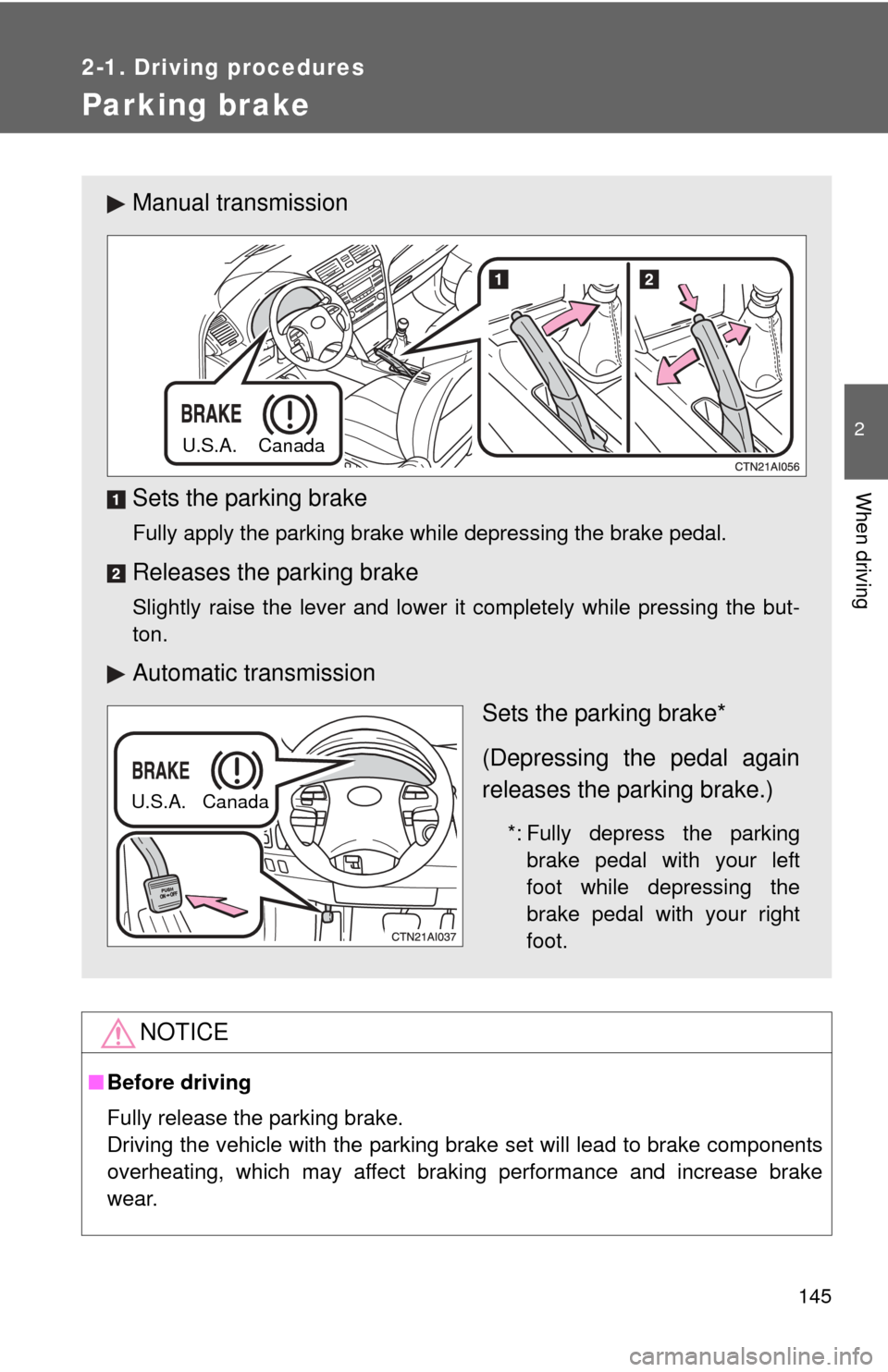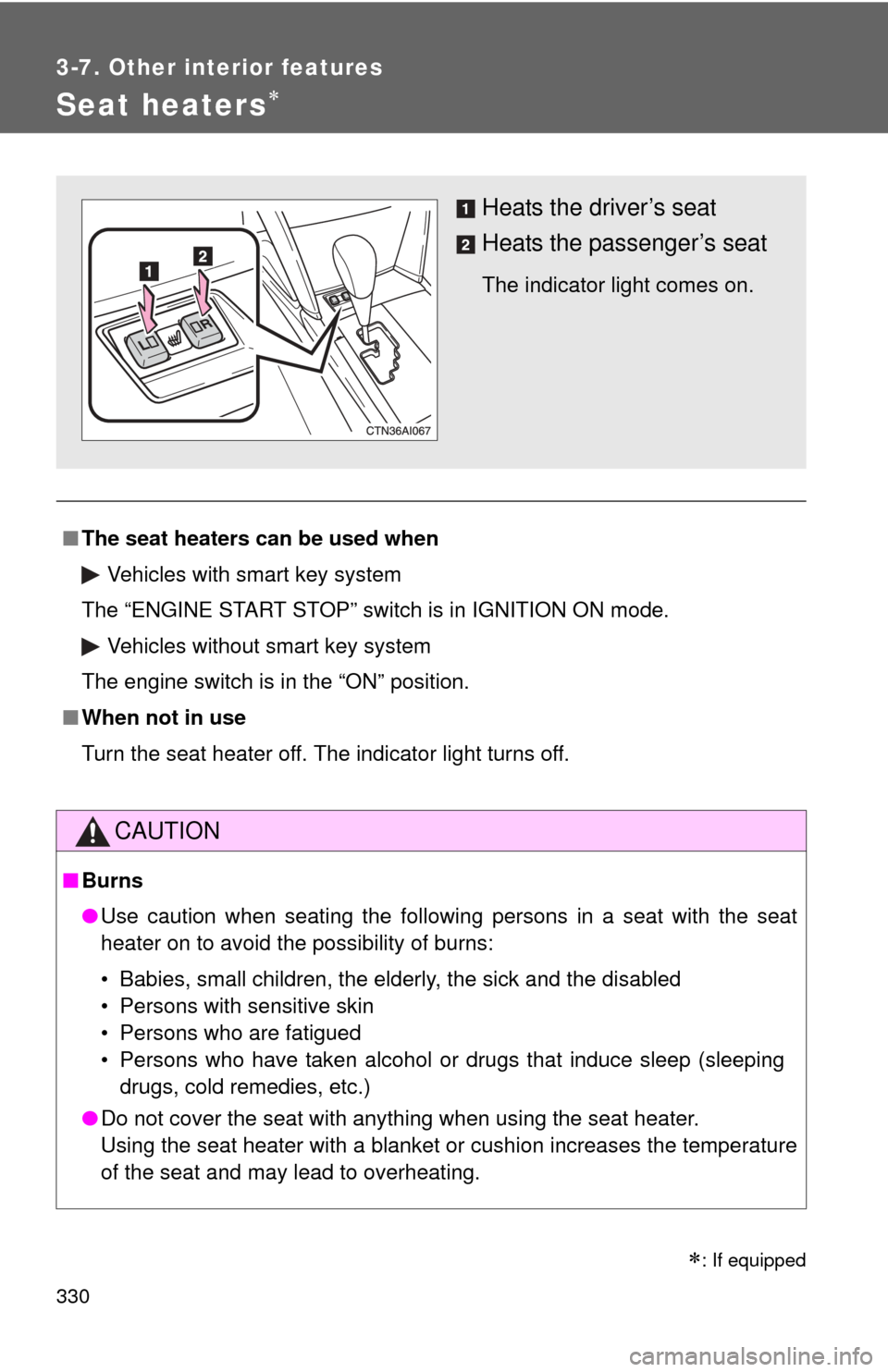2010 TOYOTA CAMRY heating
[x] Cancel search: heatingPage 127 of 538

127
2-1. Driving procedures
2
When driving
CAUTION
■
Exhaust gases
Exhaust gases include harmful carbon monoxide (CO) that is colorless and
odorless. Inhaling exhaust gases may lead to death or a serious health haz-
ard.
●If the vehicle is in a poorly ventilated area, stop the engine. In a closed
area, such as a garage, exhaust gases may collect and enter the vehicle.
This may lead to death or a serious health hazard.
● The exhaust should be checked occasionally. If there is a hole or crack
caused by corrosion, damage to a joint or abnormal exhaust noise, be
sure to have the vehicle inspected and repaired by your Toyota dealer.
Failure to do so may allow exhaust gases to enter the vehicle, resulting in
death or a serious health hazard.
■ When taking a nap in the vehicle
Always turn the engine off. Otherwise, you may accidentally move the shift
lever or depress the accelerator pedal, which could cause an accident or fire
due to engine overheating. Additionally, if the vehicle is parked in a poorly
ventilated area, exhaust gases may collect and enter the vehicle, leadin\
g to
death or a serious health hazard.
Page 145 of 538

145
2-1. Driving procedures
2
When driving
Parking brake
NOTICE
■Before driving
Fully release the parking brake.
Driving the vehicle with the parking brake set will lead to brake components
overheating, which may affect braking performance and increase brake
wear.
Manual transmission
Sets the parking brake
Fully apply the parking brake while depressing the brake pedal.
Releases the parking brake
Slightly raise the lever and lower it completely while pressing the but-
ton.
Automatic transmission
Sets the parking brake*
(Depressing the pedal again
releases the parking brake.)
*: Fully depress the parkingbrake pedal with your left
foot while depressing the
brake pedal with your right
foot.
U.S.A. Canada
U.S.A. Canada
Page 150 of 538

150 2-2. Instrument cluster
Instrument panel light controlThe brightness of the instrument panel lights can be adjusted.
Darker
Brighter
When the headlight switch is
turned to on, the brightness
will be reduced slightly unless
the control dial is turned fully
clockwise.
Odometer, trip meter and outside temperature display
Odometer: Displays the total distance the vehicle has been driven.
Trip meter: Displays the distance the vehicle has been driven since the
meter was last reset. Trip meters A and B can be used to record and
display different distances independently.
Outside temperature: Displays the outside temperature.
Automatic transmission shift position indicator lights
P. 138
Automatic transmission shift range display
P. 138
NOTICE
■To prevent damage to the engine and its components
●Do not let the indicator needle of the tachometer enter the red zone, which
indicates the maximum engine speed.
● The engine may be overheating if the engine coolant temperature gauge is
in the red zone (H). In this case, immediately stop the vehicle in a safe
place, and check the engine after it has cooled completely. (
P. 475)
Page 189 of 538

189
2-5. Driving information
2
When driving
●
In order to maintain efficient engine braking and electrical charging
performance, do not use overdrive (automatic transmission) or the
5th gear (manual transmission).
● Due to the added load of the trailer, your vehicle's engine may
overheat on hot days (at temperatures over 85°F [30°C]) when
driving up a long or steep grade. If the engine coolant temperature
gauge indicates overheating, immedi ately turn off the air condition-
ing (if in use), pull your vehicle off the road and stop in a safe spot.
( P. 475)
● Always place wheel blocks under both the vehicle and the trailer
wheels when parking. Apply the parking brake firmly, and put the
transmission in P (automatic transmission) or in first or R (manual
transmission). Avoid parking on a slope, but if unavoidable, do so
only after performing the following:
Apply the brakes and keep them applied.
Have someone place wheel blocks under both the vehicle and
trailer wheels.
When the wheel blocks are in pl ace, release the brakes slowly
until the blocks absorb the load.
Apply the parking brake firmly.
Shift into first or R (manual transmission) or P (automatic
transmission) and turn off the engine.
● When restarting after parking on a slope:
With the transmission in the P position (automatic transmis-
sion) or the clutch pedal (m anual transmission) depressed,
start the engine. On vehicles with an automatic transmission,
be sure to keep the brake pedal pressed.
Shift into a forward gear. If reversing, shift into the R position.
Release the parking brake (also brake pedal on vehicles with
automatic transmission), and sl owly pull or back away from
the wheel blocks. Stop and apply the brakes.
Have someone retrieve the blocks.
STEP1
STEP2
STEP3
STEP4
STEP5
STEP1
STEP2
STEP3
STEP4
Page 332 of 538

330
3-7. Other interior features
Seat heaters
■The seat heaters can be used when
Vehicles with smart key system
The “ENGINE START STOP” switch is in IGNITION ON mode.
Vehicles without smart key system
The engine switch is in the “ON” position.
■ When not in use
Turn the seat heater off. The indicator light turns off.
CAUTION
■Burns
●Use caution when seating the following persons in a seat with the seat
heater on to avoid the possibility of burns:
• Babies, small children, the elderly, the sick and the disabled
• Persons with sensitive skin
• Persons who are fatigued
• Persons who have taken alcohol or drugs that induce sleep (sleeping
drugs, cold remedies, etc.)
● Do not cover the seat with anything when using the seat heater.
Using the seat heater with a blanket or cushion increases the temperature
of the seat and may lead to overheating.
Heats the driver’s seat
Heats the passenger’s seat
The indicator light comes on.
: If equipped
Page 478 of 538

476 5-2. Steps to take in an emergency
■Overheating
If you observe the following, your vehicle may be overheating.
●The engine coolant temperature gauge enters the red zone or a loss of
power is experienced.
● Steam is coming from under the hood.
CAUTION
■To prevent an accident or injury when inspecting under the hood of
your vehicle
● If steam is seen coming from under the hood, do not open the hood until
the steam has subsided. The engine compartment may be very hot, caus-
ing serious injury such as burns.
● Keep hands and clothing away from the fan and other belts while the
engine is running.
● Do not loosen the coolant reservoir cap while the engine and radiator are
hot.
Serious injury, such as burns, may result from hot coolant and steam
released under pressure.
Add engine coolant if neces-
sary.
Water can be used in an emer-
gency if engine coolant is
unavailable.
(P. 488)
Have the vehicle chec ked at the nearest Toyota dealer as soon as
possible.
STEP6
Page 526 of 538

524 Alphabetical index
Back-up lightsWattage ................................. 494
Battery Checking ............................... 378
If the vehicle has discharged battery ................................. 471
Preparing and checking before winter .................................. 179
Bluetooth
® audio ..................... 263
Bluetooth® phone .................... 279
Brake
Fluid ...................................... 375
Parking brake ........................ 145
Brake assist .............................. 170
Break-in tips ............................. 122
Care
Exterior .................................. 348
Interior ................................... 350
Seat belts .............................. 351
Cargo capacity ......................... 175
Cargo net .................................. 337
CD changer ............................... 223
CD player .................................. 223
Chains ....................................... 179
Child restraint system Booster seats, definition ........ 104
Booster seats, installation ..... 108
Convertible seats, definition ............................. 104
Convertible seats,
installation ........................... 108
Front passenger occupant classification system .............99
Infant seats, definition ........... 104
Infant seats, installation......... 108
Installing CRS with LATCH anchors ............................... 109
Installing CRS with seat belts ............................ 111
Installing CRS with top straps .................................. 114 Child safety
Airbag precautions .................. 94
Battery precautions ....... 380, 473
Child restraint system ........... 104
Child-protectors....................... 43
How your child should wear
the seat belt .......................... 61
Installing child restraints........ 108
Moon roof precautions ............ 75
Power window lock switch ...... 70
Power window precautions ..... 71
Removed key battery
precautions ......................... 403
Seat belt comfort guide ........... 58
Seat belt extender
precautions ........................... 64
Seat belt precautions .............. 62
Seat heater precautions ........ 330
Trunk precautions ................... 49
Child-protectors ......................... 43
Cleaning
Exterior.................................. 348
Interior ................................... 350
Seat belts .............................. 351
Clock ......................................... 326
Compass................................... 343
Condenser ................................ 374
Console box ............................. 317
Cooling system Engine overheating ............... 475
Cruise control .......................... 166
Cup holder ................................ 319
Curtain shield airbags ............... 87
Customizable features ............ 510
B
C
Page 528 of 538

526 Alphabetical index
EngineCompartment ........................ 365
Engine switch ................ 131, 135
Hood...................................... 362
How to start the
engine ......................... 131, 135
Identification number ............. 482
If the engine will not start ...... 465
Ignition switch................ 131, 135
Overheating........................... 475
Engine compartment cover..... 367
Engine coolant
Capacity ................................ 488
Checking ............................... 373
Preparing and checking before winter .................................. 179
Engine coolan t temperature
gauge ...................................... 147
Engine immobilizer system.......80
Engine oil Capacity ................................ 485
Checking ............................... 368
Preparing and checking before winter .................................. 179
Engine oil maintenance data ......................................... 371
Engine switch light .................. 313
Event data recorder ................. 430 Floor mat .................................. 335
Fluid
Brake..................................... 375
Power steering fluid .............. 376
Washer.................................. 381
Fog lights Switch ................................... 163
Wattage................................. 494
Front fog lights Switch ................................... 163
Wattage................................. 494
Front passenger occupant classification system .............. 99
Front passenger's seat belt
reminder light ........................ 435
Front seats Adjustment .............................. 51
Front side marker lights Wattage................................. 494
Front turn signal lights
Wattage................................. 494
Fuel Capacity ................................ 484
Fuel gauge ............................ 147
Fuel pump shut off system .... 429
Gas station information ......... 536
Information ............................ 495
Refueling ................................. 76
Type ...................................... 484
Fuel door .................................... 76
Fuel filler door ............................ 76
Fuel pump shut off system ..... 429
Fuses ........................................ 405F